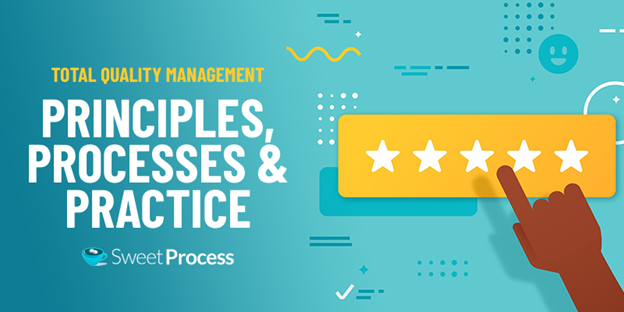

Maybe scores of your customers return their products, angrily requesting refunds. Or maybe the output of your team isn’t quite at the level you want it.
The problem may not be your team but your processes and systems.
The quality of your products or services depends on the efficiency of your processes. Inefficient processes will often result in shoddy services and subpar products.
Who then is responsible for the quality of the final product? Top-level managers? Product designers? Or the customer service department?
The answer? Everyone.
The essence of a total quality management (TQM) effort is in its totality. Hence, every employee involved in the process of making a product or providing a service should be involved in implementing quality.
In this article, we’ll explore the concept of total quality management, its genesis and evolution, and its benefits and applications, including strategies you can use to improve your processes and the quality of your products or services.
Let’s get right into it.

Total quality management is a management strategy focused on the continual improvement of business processes with maximum customer satisfaction as the overarching goal.
Unlike other strategies that are exclusive to top management, the participation of every employee is crucial to the successful deployment of TQM effort.
TQM aims to improve existing quality standards and improve the quality of products and services, while inculcating a culture of collaboration between various departments in an organization.
As Khurram Hashmi succinctly puts it, TQM is:
“…a management philosophy that seeks to integrate all organizational functions (marketing, finance, design, engineering, and production, customer service, etc.) to focus on meeting customer needs and organizational objectives.”
In the quest for quality, Six Sigma and TQM can be confused because they are both quality management tools. They have numerous similarities and are viable in many similar business scenarios ranging from administration to assembly.
However, the fundamental difference between Six Sigma and TQM is in their approach. Six Sigma is a tool for quality management with a focus on fewer defective products rather than improved processes or systems. It is data-driven and based on data from highly accurate sources.
TQM, as we’ve described, is a management strategy that involves every employee in the quality process with the overarching goal of customer satisfaction.
Although Six Sigma helps many businesses grow, there are critical business aspects it may neglect. For example, it may focus only on improving quality while ignoring things like revenue. TQM, on the other hand, is a more comprehensive approach because it provides solutions aimed at consistent improvement across the board.
Another key difference between both management strategies is how they describe “quality.”
TQM qualifies a “high-quality product” based on how well the product aligns with the customer’s wants and how it meets the customer’s expectations.
Six Sigma, however, qualifies services with zero errors and low product defects as high-quality products (or services).
However, by targeting all the bases of your operations, TQM can help to strengthen your competitive position, enhance your market image and increase customer loyalty and retention.
Before the industrial revolution, craftsmen used to be involved in the production process from start to finish. And the incentive for excellence was artisanal pride and reputation.
But as production processes became decentralized, and as the division of labor became widely adopted, workers became less involved with the finished product and had less incentive to maintain quality standards. Artisanal pride had become relatively unimportant.
In the late 1800s, however, Frederick Winslow Taylor (known as the father of scientific management) emphasized product inspection as a way to ensure consumers received better products. Quality then became traditionally understood as the activity of inspection.
But this wasn’t sustainable. It was costly and since quality was only applied to the finished product, future defects could not be prevented.
The first true pioneer of quality management was Walter A. Shewhart, a former Bell Telephone employee often referred to as the grandfather of total quality management because he invented the process control chart in 1924. It was a tool used to monitor processes’ performance over time and examine how it varied between two established variables.
With this chart, he could predict future output and improve process management and control. This approach was the beginning of a modern approach to statistical process control (SPC). He also invented the ‘Shewhart Cycle’ and the PDCA cycle: plan, do, check, act.
In the downloadable resource you can get here, wwe’llcover the control chart in more detail.
Many years later, using Shewart’s work as a springboard, William Denning, holder of multiple degrees including a doctorate in mathematical physics from Yale, furthered the gospel of quality.
In his ten-year stint of writing and lecturing in math and physics, he became interested in Shewart’s statistical quality control principles. His goal was to expand Shewart’s principle so they could be applied to not just manufacturing, but management and administration.
He joined the U.S Census Bureau, and his implementation of Shewhart’s principles resulted in a six-fold increase in productivity while he was there.
After World War II, he became involved with the Union of Japanese Scientists and Engineers. His contributions led to the rehabilitation of Japan’s post-war economy.
Japan’s aggressive approach to quality ensured that by the 1980s, there was a clear competitive gap between Japanese and American products, with Japanese products acknowledged to be more reliable.
The Americans sought his expertise as they scrambled to close the cavernous gap.
One of the first companies to do this was Ford. Already with sales losses of $3 billion dollars, they sought Denning’s expertise, and he was able to implement management strategies that transformed the Ford Motor company to America’s most profitable auto company.
The next important element in the evolution of total quality management was Joseph Juran.
Working with Bell Technologies first exposed engineer Joseph Juran to statistical sampling and quality control. Over the space of four decades, he honed and refined his skills and reputation as a quality management expert.
In 1951, he published his acclaimed book The Quality Control Handbook. His reputation spread not just nationally in the U.S. but worldwide.
In 1954, just like Denning, the Union of Japanese Scientists and Engineers invited him to discuss the theories and strategies he had developed over the years. While there, he discussed his theories, three of which were:
After Denning and Juran laid most of the foundation for TQM, Armand Feigenbaum published his book Total Quality Control and outlined the costs of poor quality and non-conformance.
He classified the costs of quality into four: prevention costs, appraisal costs, internal failure costs, and external failure costs. He also pioneered the philosophy of involving everyone in the quality process.
Later we’ll examine these four costs in more detail.

Adopting TQM comes with many benefits. But the main one is improved customer satisfaction as a result of fewer defective products and fewer service errors.
The following are some of the benefits of adopting TQM as a management strategy.
Whenever a TQM strategy is implemented, it makes processes more efficient and effective. Efficiency shaves off excess cost in the aspect of field warranty, field service, and rework.
Reduction of cost can help companies optimize revenue because these reduced costs flow directly into net profit.
Finally, TQM places a strong emphasis on quality improvement, reducing the need to employ or hire an expensive team of quality assurance personnel to detect errors.
One of the benefits of TQM is increased productivity.
Improved systems are one of the benefits of TQM. Workers don’t have to spend time detecting and correcting errors. They can instead focus on their jobs which improves their overall output.
In addition, one of TQM’s core principles focuses on improving systems, which could include providing conducive working environments. Doing this will boost workers’ morale. Their job performance will go up and turnover rates will drop too.
If you offer a good product to your customers and it satisfies their needs, they will come back to buy again and again.
Also, a high level of customer satisfaction can lead to an increased market share, as existing customers do free advertising for the company by doing word-of-mouth marketing.
Customer satisfaction makes it easier to:
Besides, your company’s insistence on creating error-free products leads to fewer customer complaints and refunds. This means you get to save resources that would have been spent on customer service.
The proven success of TQM, especially the contribution of workers to that success, can motivate them to do more.
And since the focus of TQM is to engage every employee, workers feel more like they belong and that they are a part of something bigger. This can be very satisfying for many employees.

Total quality management leads to a wide range of improvements in any company that adopts it. Below are some of the many aspects of a business that are positively influenced by adopting TQM strategies.
Monitoring performance metrics such as quality data defect rates, scrap rates, error rates, defects, and rework rates helps a company predict what will be spent on production and how much they’re losing to errors.
Monitoring performance metrics also helps to create error-proof systems that minimize future errors.
Having a practical knowledge base where employees can learn about quality concepts and techniques can help them implement quality management measures the right way.
It also helps managers to monitor and analyze workers’ progress so that their performance can be improved and their productivity optimized.
Working closely with your company’s suppliers and involving them in product development helps in making sure they deliver high-quality materials.
This is because the principal insists on quality and not cheaper prices when looking to work with suppliers.
Better services and products will up your company’s sales volumes and net profits. Customer complaints and bad reviews will be reduced.
Conversely, company sales, customer retention, return on assets, and market share especially will increase too.
Another aspect that improves when you implement TQM is the environment. Implementing TQM strategies can result in a significant reduction of gas emissions, pollution, and noise levels from machinery.
Leveraging social responsibility can also lead to increased brand equity since some customer segments may want to identify with socially responsible businesses.

To implement TQM, you can take a few different approaches or you can even combine many approaches together to achieve your goals.
But TQM consists of a few guiding principles. They include the following:
One of the most important goals of TQM is satisfying the needs of your customers. Your product or service must meet their expectations, including the quality, shape, size, and delivery of the product before they can feel like they got value for their money.
Once you figure out exactly what your customers want, it’s easier to find the right employees, raw materials, and the processes that can satisfy and even exceed these expectations.
To implement this TQM principle you have to:
The benefits of being focused on your customer’s needs include:
It’s impossible to improve your productivity, processes, or revenue without the dedication of your employees.
However, you need to ensure that they understand your company’s vision and goals. They also need proper training and the correct resources to carry out their duties in a timely manner.
To implement this TQM principle:
The key benefits of this principle include:
Sticking to processes is essential in quality management as they help in speeding up the production process.
To implement this TQM principle:
Benefits of this TQM principle include:
Many businesses usually have different departments with separate functions. Because they all operate separately, it tends to lower the organization’s output.
However, integrated systems help every employee and stakeholder fully understand the policies, objectives, and processes in an organization which leads to continuous improvement over time. This leads to more competitive advantage.
To implement this TQM principle:
The benefit of this TQM principle include:
According to the International Organization for Standardization (ISO), this principle is essentially “Identifying, understanding and managing interrelated processes as a system contributes to the organization’s effectiveness and efficiency in achieving its objectives.”
To implement this TQM principle:
Benefits of this principle include:
Getting to the point where you consistently exceed your customers’ expectations doesn’t happen in a day.
Your business needs to keep on improving the quality of your products and services, in line with your customers’ desires.
To implement this TQM principle:
Benefits of this TQM principle include:
The essence of this principle is making decisions based on hard data and not mere assumptions.
To implement this TQM principle:
Benefits of this principle include:
You need to ensure that every employee in your organization is aware of all the strategies, plans, and methods you intend to use to achieve company goals.
To implement this TQM principle you need to:
Benefits of this principle include:
The PDCA model is a continuous loop of planning, doing, checking (or studying), and acting. It provides a simple and effective approach for solving problems and managing change. It is used to understand why some products or processes are ineffective.
Pioneered by Walter Shewhart, the PDCA approach includes four different stages/phases:
Planning starts with first recognizing an opportunity for change so you can make plans to effect change.
The opportunity could be improving the quality of finished products or making existing marketing strategies more effective.
After you have identified and isolated the problem, the next thing to do is to brainstorm ideas and strategies you can implement to solve the problem.
But while you’re doing this, ensure that you establish measurable criteria that you can use to evaluate your efforts later at the check phase.
Once you’ve found a viable solution, it’s better to first test it on a small scale.
For example, you could organize a test run within the department, in a small area, or with a certain demographic.
As you run the trial, carefully collect data you can use to evaluate the effectiveness of your actions. You’ll need it in the next stage.
To ensure the effectiveness of any plan before you think about implementing it, review the effects of your actions.
Analyze the results and identify what you learned. Doing this will help you refine the cycle to the point where you can successfully execute the plans you made in step 1.
This is where you apply your solution. But remember that PDCA/PDSA is a continuous process.
Even though your improved process or product becomes the new standard, you still have to continue planning, checking, and doing things to improve them.

In the words of Emma Harris:
“The process approach includes establishing the organization’s processes to operate as an integrated and complete system.”
To get the best results from a process standpoint, you need to implement each of these steps into your TQM strategy:

The key benefit of using TQM software is the digital documentation of company processes.
It is time-consuming to manually record every process. However, using TQM software makes it quicker with the added benefit of providing an all-in-one knowledge resource for all departments.
A good TQM software should help in continuous auditing, keeping data organized, including company standards and regulations.
A good example of software that can help you implement TQM is SweetProcess. With SweetProcess, you can create a knowledge base that your employees will find useful. It will not only save you from having to perform hands-on training, but it will also help your new hires to acclimate more quickly to work environments.
Cost of quality is a method used to determine where an organization’s resources are being used to prevent product defects and maintain product quality.
These four quality costs are: prevention costs, appraisal costs, internal failure costs, and external failure costs.
Preventive costs are expenses or monies spent to reduce the number of defects in products and services.
There are many easy ways to do this.
For instance, a company might use statistical process control analysis to detect procedures that result in inferior quality goods.
Another firm can spend on certification programs to be sure the raw materials they buy from suppliers meet certain standards.
But one effective way of going about prevention is providing adequate training.
A company that invests in training its team, arming it with the right tools for the job, will get value for its investment and save itself many future headaches.
A poignant example is Zen Media. By creating a knowledge base resource for its staff, they were able to improve the performance of their team and keep their performance levels consistent.
It is an effective strategy because it is significantly less expensive compared to selling defective products which might lead to:
Preventive costs are grouped into four categories:
One of the biggest benefits of preventive costs is that they are less expensive to the company, compared to spending on correcting or replacing the defective products. Along with saving a lot of effort and time, they also help in building a company’s reputation.
The following are some examples of preventive costs:
Some of these include the expense company incurs in doing a full analysis when introducing a new product or design. For instance: FMEA (failure mode and effects analysis), review of product design, etc.
It includes the cost of studying process capabilities and planning inspection. It also includes similar costs for other activities that relate to production stages.
This is the cost for in-process inspection, or the cost to determine the accuracy of a process. For instance: SPC (statistical process control), Anova Studies, and more.
This includes the cost to evaluate the supplier before finalizing the deal so that the input material does not create any quality issues down the line.
This includes the money spent on organizing the training of employees. It is also the expense of improving, updating, and maintaining the course/training content too.
Other forms of costs that companies are more concerned about are:
However, spending on prevention costs is a lot better.
This is because preventing product defects helps to minimize all the other costs including appraisal costs along with internal and external failure meets customer expectations costs.
Appraisal costs are the costs incurred during the activity of inspecting products before they get to the customer. Although appraisal costs aren’t cheap, it’s less expensive to incur costs that arise when customers get low-quality goods.
The costs associated with losing a customer include the marketing costs to acquire the customer in the first place as well as the subsequent profits that could have been achieved from a positive relationship with the seller.
It’s desirable for appraisal to happen early in the production process because if it happens at the end, where labor and time have been expended, the resulting losses will be much more, compared to if issues have been found and addressed earlier on.
Keeping appraisal costs down can be achieved by improving production processes and monitoring incoming supplies. This way the system is incapable of producing defective processes in the first place.
Examples of appraisal costs include:
A short but not-so-sweet example:
While Samsung is a leading technological company, it made some serious quality mistakes in 2016. Because of tolerance issues caused by battery suppliers, their S7 Galaxy smartphones began seriously overheating, and in some cases exploding.
As you can imagine, the headlines brandished their mistake in the eyes of millions of readers. The internet became rife with mocking memes.
Although Samsung estimated it would cost them $1 billion to recall all the faulty phones, they ended up losing five times that. Not only that, they faced a humongous disposal cost north of $500 billion.
Luckily, they didn’t go under because of their diverse wide-ranging portfolio.
If only they had been a bit more attentive…
This type is costs that are spent to remove errors from the products before taking them to consumers. Examples of internal failure costs include:
If customers receive low-quality products or substandard services, the resulting costs of shipping replacements or providing refunds are dubbed external failure costs.

Kenya Airways are the quintessential example of the effects of what could happen when a company doesn’t pay enough attention to quality.
Because of low-quality standards in Kenya Airways, the airline has had a hard time coping with other airlines in developed countries.
The following have been the consequences:
Imagine what would happen if Kenya Airways radically began taking steps to raise and implement quality standards like regulating prices and training their staff?
It’s likely they will begin to provide more consistent services to their customers, which is the main focus of any TQM initiative anyway.
Addressing these problems can potentially unlock the industry’s growth as the air transport sector can boost Kenya’s economic prosperity.

At the other end of the spectrum is Toyota Motors.
Although they started as a small car manufacturer on August 28, 1937, Toyota is one of the earliest pioneers of quality.
Their “customer first” philosophy, kaizen (continuous improvements), as well as careful customer targeting and their multitude of offerings to different categories of customers cemented their place as one of the leading manufacturers of cars—not just in Japan, but in the world.
They introduced statistical quality control (SQC) in 1949 and later the “creative idea suggestion system” to encourage workers to contribute ideas to help solve company problems.
These concepts are at the core of TPS, Toyota’s production system, also called the “Toyota Way,” which has led to some stunning successes:
Ford Company
Ford didn’t join the TQM party on time.
However, in 1980, Ford went into a partnership with ChemFil to improve their painting design to meet customers’ expectations.
They wanted to make quality products and provide a work-friendly environment for their employees to meet those expectations.
The move to adopt TQM, and the joint venture, led to progress in the following ways:
Samsung
Samsung is known as a successful smartphone brand today. However, in the past, they were unsuccessful, despite releasing their first smartphone in the 1980s.
With Motorola leading the mobile devices market with about 60% market share, Samsung struggled to grab a measly 10%.
Because of the poor sales volumes and the backlash they received for poor user experience and performance, in 1995 the company decided to change its strategy.
Led by then-chairman Lee Kun-hee to improve the quality of Samsung devices, by adopting TQM, Samsung invested in creating products with a positive user experience.
Years later, the company grew and expanded as a tech brand. Some of its successes include:
Customer satisfaction is the focus of the TQM philosophy. It is, therefore, important for key business decisions to be made with the customer in mind.
Where possible, the customer should be engaged in the product/service design and development process to give suggestions that may reduce or prevent manufacturing waste and product defects.
American companies did not take the business-customer integration loop seriously until the Japanese brands used it to transform their economy and dominate the global market after the Second World War.
Today, most companies like Toyota, Samsung, and Apple all use the business-customer integration loop to grow their revenue and increase their market share.
Many empirical studies confirm that companies with a quality-oriented strategy have achieved:
Involve your customers as much as you can with your processes and you’re much more likely to meet and even exceed their expectations.
Large-scale businesses don’t solely focus on profits. Rather, they find their target audience, satisfy their needs and easily keep market share by improving their products and services.
Total quality management (TQM) is a smart system which small businesses can use to grow their company.
This is because they are often the suppliers to big companies. Low-quality materials from their end will affect the output of large businesses too.
Only small-scale businesses that maintain quality can compete in the marketplace.
TQM can not only be applied to large multi-million dollar companies, but also small companies just starting out.
 Two Simple Ways for Small Businesses to Implement TQM" width="624" height="312" />
Two Simple Ways for Small Businesses to Implement TQM" width="624" height="312" />
Every business is unique and there are many ways you can implement TQM. Below are two simple ways:
For example, Walmart has a no-hassle return policy for their products—with or without a receipt.
Why Does it Work?
Customer satisfaction is at the heart of TQM.
And simple things like extending service hours and warranties can make customers more satisfied with their purchases.
However, for TQM to help in improving quality in a company, there has to be:
Preventing and reducing errors is one effective way to improve quality.
However, it’s difficult to achieve this without having a strong leadership and skillful staff or a reliable and continuous process to prevent errors. Some of these processes include Poka-yoke, the 8D method, using digital software.
The 8D method is a detailed approach to solving critical issues in the production process.
Its steps include the following:
Manual work instructions might have errors, so you may need to use work instruction software to create, automate and manage your work instructions.
They prevent operators from making errors and help you reduce product defects too.
The Poka-yoke (Poh-kay-yo-kay) is the Japanese equivalent of fail-safing or mistake-proofing. It is a process analysis tool involving the use of an automatic device or method that either makes it impossible for mistakes to occur or makes it immediately obvious whenever an error occurs.
The mistake-proofing procedure is as follows:

The team at Turkstra Lumber was already good at their job.
But they weren’t coordinated, and wanted to do better. They wanted to improve. They wanted better results.
They had only ever used Excel sheets to outline processes and procedures. But it wasn’t enough, as team members would have to jump through hoops just to solve problems that could have easily been tackled had there been documented procedures they could use as reference.
Luckily, an MBA intern discovered SweetProcess. After using and implementing the software, it was found that team members were more eager and likely to participate.
The team became more efficient as a result.
Instead of spending time jumping through hoops looking for crucial information, they could more fully focus on their roles.

Involving employees is an important element of any TQM strategy. It’s important to have well-written, accessible processes that everyone can use without needing the feedback of top-level management all the time.
Empower your team to deliver supercharged results with SweetProcess, a powerful all-in-one platform that allows you to document your processes, policies and procedures in a centralized manner.
By creating a knowledge base with SweetProcess, you can significantly improve the quality of your team’s output and keep new hires out of your hair.
You can document processes and policies, assign and manage tasks, and create rich useful knowledge bases all using SweetProcess.
Get more done with SweetProcess.
Sign up for a 14-day trial today without your credit card for an opportunity to supercharge your business process documentation and improve the quality of your work.
And if you’d like to learn about some powerful yet easy-to-use tools that quality professionals rely on to drive quality, check out the resource below.